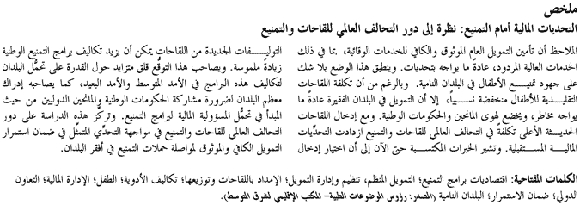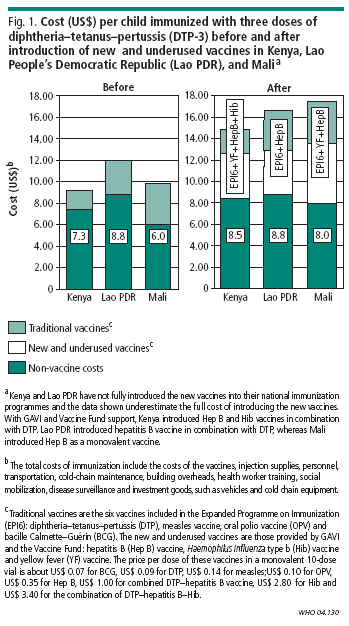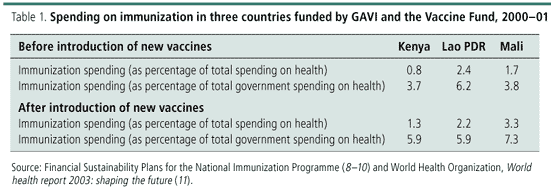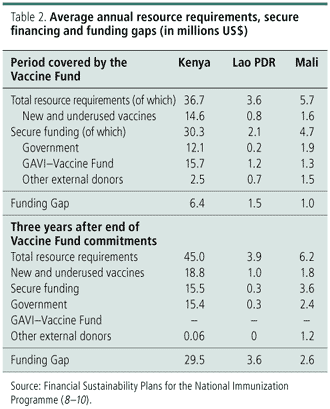POLICY AND PRACTICE
Financial challenges of immunization: a look at GAVI
Défis financiers rencontrés par la vaccination : un regard sur la réponse de l'Alliance mondiale pour les vaccins et la vaccination (GAVI)
Los retos financieros de la inmunización: el caso de la GAVI
Miloud KaddarI,1; Patrick LydonII; Ruth LevineIII
IHealth Economist, Department of Immunization, Vaccines and Biologicals, World Health Organization, CH-1211 Geneva 27, Switzerland (email: kaddarm@who.int)
IIHealth Economist, Department of Immunization, Vaccines and Biologicals, World Health Organization, Geneva, Switzerland
IIISenior Fellow and Director of Programs, Center for Global Development, Washington, DC 20036, USA
ABSTRACT
Securing reliable and adequate public funding for prevention services, even those that are considered highly cost effective, often presents a challenge. This has certainly been the case with childhood immunizations in developing countries. Although the traditional childhood vaccines cost relatively little, funding in poor countries is often at risk and subject to the political whims of donors and national governments. With the introduction of newer and more costly vaccines made possible under the Global Alliance for Vaccines and Immunization (GAVI), the future financial challenges have become even greater. Experience so far suggests that choosing to introduce new combination vaccines can significantly increase the costs of national immunization programmes. With this experience comes a growing concern about their affordability in the medium term and long term and a realization that, for many countries, shared financial responsibility between national governments and international donors may initially be required. This article focuses on how GAVI is addressing the challenge of sustaining adequate and reliable funding for immunizations in the poorest countries.
Keywords: Immunization programs/economics; Financing, Organized/organization and administration; Vaccines/supply and distribution; Drug costs; Child; Financial management; International cooperation; Sustainability; Developing countries (source: MeSH, NLM).
RÉSUMÉ
Assurer un financement public fiable et suffisant aux services de prévention, même si ceux-ci sont considérés comme ayant un bon rapport coût-efficacité, représente souvent un défi. C'est assurément le cas pour les vaccinations infantiles dans les pays en développement. Bien que les vaccins infantiles classiques soient relativement peu coûteux, leur financement dans les pays pauvres est souvent menacé et soumis aux caprices politiques des donateurs et des gouvernements nationaux. Avec l'introduction de vaccins plus récents et plus coûteux, rendue possible par l'Alliance mondiale pour les vaccins et la vaccination (GAVI), les défis financiers à affronter dans l'avenir sont devenus encore plus grands. L'expérience acquise jusqu'à présent laisse à penser que l'option consistant à introduire de nouveaux vaccins combinés peut augmenter de manière importante les coûts des programmes nationaux de vaccination. Cette expérience inspire une inquiétude grandissante quant à la capacité des pays à se procurer ces vaccins à moyen et long terme et nous amène à réaliser que, pour nombre d'entre eux, une responsabilité financière partagée entre les gouvernements nationaux et les donateurs internationaux pourrait initialement être nécessaire. Cet article porte principalement sur la manière dont l'Alliance fait face au défi consistant à assurer durablement un financement suffisant et fiable des vaccinations dans les pays les plus pauvres.
Mots clés: Programmes de vaccination/économie; Organisation financement/organisation et administration; Vaccins/ressources et distribution; Coût médicament; Enfant; Gestion financière; Coopération internationale; Durabilité; Pays en développement (source: MeSH, INSERM).
RESUMEN
Asegurar una financiación pública fiable y suficiente de los servicios de prevención, incluso de los considerados muy costoeficaces, supone a menudo todo un desafío. Éste ha sido sin duda el caso de la inmunización infantil en los países en desarrollo. Aunque las vacunas tradicionales de la niñez cuestan relativamente poco, la financiación en los países pobres peligra a menudo y está sujeta a los caprichos políticos de los donantes y los gobiernos nacionales. Con la introducción de vacunas nuevas y más costosas que ha hecho posible la Alianza Mundial para Vacunas e Inmunización (GAVI), los retos financieros de cara al futuro son ahora aún mayores. La experiencia adquirida indica que la decisión de introducir nuevas combinaciones de vacunas puede aumentar considerablemente los costos de los programas nacionales de inmunización. Esta experiencia trae asociada una creciente preocupación sobre su asequibilidad a medio y a largo plazo, y el reconocimiento de que en muchos países puede requerirse al principio un reparto de la responsabilidad financiera entre los gobiernos nacionales y los donantes internacionales. Este artículo se centra en la manera en que la GAVI está abordando el reto de garantizar una financiación suficiente y fiable de las inmunizaciones en los países más pobres.
Palabras clave: Programas de inmunización/economía; Organización del financiamiento/organización y administración; Vacunas/provisión y distribución; Costos en drogas; Niño; Administración financiera; Cooperación internacional; Sostenibilidad; Paises en desarrollo (fuente: DeCS, BIREME).

Introduction
It is difficult to understand why financing for immunization is seen as a problem when it is largely accepted that immunization represents the "best buy" for the health sector and that its financing is primarily a national public responsibility. Equally, the international community recognizes that immunization is a global public good in that it provides global health benefits and positive externalities. Furthermore, with a renewed global effort to reduce infant mortality a key objective of the Millennium Development Goals the global financing context should be favourable.
Despite these arguments, financing for vaccines and immunization still remains far from assured. To a large extent many low-income countries continue to rely heavily on international assistance in the form of grants, budgetary support and loans from development banks to cover key programme inputs, particularly vaccines and capital equipment. This is the case even for immunization programmes that include only the least expensive traditional vaccines, which are available for less than US$ 0.15 cents per dose. The result is volatile financing for immunization and programmes that are vulnerable to any shifts in donor priorities.
In recent years, the issues involved in vaccine and immunization financing have broadened due to several factors: (i) the evolving world market for vaccines, including increasing divergence in vaccination schedules between developed and developing countries; (ii) the increasing diversity of products and presentations available to countries; (iii) the emergence of manufacturers in developing countries; and (iv) the importance of new global initiatives such as the Global Alliance for Vaccines and Immunization (GAVI) that have rejuvenated global immunization efforts by providing five-year grant funding to assist low-income countries strengthen their immunization infrastructure and introduce underused vaccines such as yellow fever and more costly new vaccines such as hepatitis B and Haemophilus influenzae type b (Hib), including in combination form with diphtheriatetanuspertussis (DTP). While the added health benefits are potentially significant, the expansion of vaccination schedules to include such vaccines has increased the volume of resources that need to be mobilized for programmes by several orders of magnitude.
This paper focuses on how GAVI has conceptualized and made progress towards resolving the challenge of sustaining adequate and reliable funding for immunization in poorer countries. We present GAVI's approach to long-term financing for immunization and indicate how it has tackled this issue through the use of financial sustainability plans. The paper presents the findings from this experience in three countries that have been on the leading edge of this work, identifies some of the founding assumptions, describes some of the lessons learnt, and offers suggestions of ways to move forward.
The GAVI approach to financing
The issue of financing for vaccines and immunization is not new (13). However, it has been placed at the forefront of the global immunization agenda with the advent of GAVI (4). Given the time-bound nature of the funding, partners in the alliance were concerned from the outset about how governments would move away from the five years of support provided through the Vaccine Fund.
GAVI has sought to address the question of financing in a systematic way (5, 6). It has done so, first, by providing multi-year country commitments for vaccines and immunization: five years is beyond the standard length of a firm commitment of external funding. Second, it has defined financial sustainability in a way that supports the achievement of the immunization programme's long-term objectives rather than conceptualizing self-sufficiency as an end in itself.
It was recognized that for many poor countries, which have little room to increase health spending, programmes seeking to reach ambitious objectives for increasing coverage and expanding the number of vaccines (or antigens) administered will require external funding in the short term and medium term, as well as increases in national government commitments. In June 2001, the Board of GAVI accepted the following definition of financial sustainability: "Although self-sufficiency is the ultimate goal, in the nearer term sustainable financing is the ability of a country to mobilize and efficiently use domestic and supplementary external resources on a reliable basis to achieve current and future target levels of immunization performance in terms of access, utilization, quality, safety and equity" (7). By accepting this definition, GAVI is moving away from an earlier conceptualization that equated financial sustainability with self-sufficiency.
Third, GAVI has required all countries receiving Vaccine Fund grants to plan midway through the funding period how they will finance the costs of immunization services and new vaccines in the future and commit to preparing a detailed Financial Sustainability Plan (FSP) that describes how the will make the transition from Vaccine Fund resources to other funds, within the context of financing the full immunization programme (7).
Tackling the financing challenge posed by GAVI is founded on several key assumptions: (i) that five years would be sufficient for countries to plan the transition away from Vaccine Fund support and move towards other sources of funding; (ii) that the GAVI push to renew the global immunization effort would catalyse additional support by partners; and (iii) that helping 75 of the poorest countries introduce costly vaccines would drive the cost of these vaccine to their mature price, which would be affordable for countries at or near the termination of the Vaccine Fund funding commitment.
Early findings from the GAVI sustainability plans
In November 2002, 12 countries were the first grant recipients to submit their FSPs. (These countries are Cambodia, Côte d'Ivoire, Ghana, Guyana, Kenya, Kyrgyzstan, Lao People's Democratic Republic, Malawi, Mali, Mozambique, Rwanda and the United Republic of Tanzania.) These plans have provided new information about the challenge of financing immunization programmes in poorer countries. Using information from three countries, we first look at immunization programme costs and the implications of introducing new vaccines. Given the uniqueness of each country and the difficulty of generalizing on the basis of 12 FSPs, the main findings are best illustrated by presenting a range of results and focusing on a selected few countries (810). Kenya, Lao PDR and Mali were chosen as illustrative cases on the basis of the quality and comprehensiveness of their costing and financing data, the health systems environment in which their immunization programmes operate, and the type of support awarded by the Vaccine Fund.
Second, we look at the question of who is paying for traditional vaccines and immunizations. Then we look at future resources needed to increase programme performance and sustain improvements with new vaccines. We also examine what financing is available to meet these needs.
What are the costs of introducing new vaccines?
One way to analyse the costs of immunization and how these change with the introduction of new vaccines is to look at the evolution of a commonly used indicator. By linking spending with immunization coverage, the cost per DTP-immunized child is an attempt to measure how well the system is doing to immunize children. The number of children fully vaccinated with all three doses of DTP (DTP-3) serves as a proxy for a fully immunized child.
Before new vaccines were introduced into their programmes, the cost per fully vaccinated (DTP-3) child ranged from US$ 9.00 in Kenya to US$ 12.00 in Lao PDR. A large part of the variability between countries is accounted for by the non-vaccine costs of the programmes and reflects differences in economies of scale or service delivery strategies (Fig. 1).

Following the introduction of new vaccines, the cost per DTP-3 child increased in the three countries. While most of the increase and variability between countries is now attributable to the cost of the different vaccination schedules, in some countries a rise in non-vaccine costs following introduction was also observed. Additional resources were needed to train health workers to administer the antigens using new injection technologies, to strengthen the cold chain in light of the increased volume of vaccines, and to intensify social mobilization efforts.
Who is currently paying for vaccines and immunization?
The findings show considerable variability across the selected countries in the internal and external mix of financing for the programmes (Fig. 2). At one end of the scale is a country such as Lao PDR that continues to rely heavily on external resources to support more than 90% of its immunization programme. At the other end of the scale the Government of Mali uses national budget resources to finance more than 90% of the costs. This is possible through a combination of internal resources and direct budgetary support provided by the European Union. While national budget support is subject to changes in donor priorities, it is considered to be a more predictable source of funding since it is conditional on the creation of a budget line-item for vaccines. Between these extremes lies Kenya, which is halfway towards becoming self-sufficient in financing its programme.

The prospects for immunization financing are highly dependent on the financing for the health sector as a whole. Since 1996, there has been a constant rise in overall and public health sector spending in Mali (11). This is in contrast to both Kenya and Lao PDR where the trends in national health accounts have not been as favourable (11). However, immunization programme-specific funding represents relatively little of the overall health sector budget (Table 1).

Relative to overall spending on health, the cost of the routine immunization programme with basic vaccines hovers at around 12% of total health sector spending in the year before new vaccines are introduced. This translates to 46% of government spending on health (including external support). Even with the increases associated with the Vaccine Fund, the cost of routine immunization services in the three countries would have represented between 1% and 3% of total spending in the health sector, or between 6% and 7% of government health spending alone.
How much is needed in the future and what are the financing gaps?
Despite uncertainties about future financing, some interesting results emerge from the three countries' projections of future costs and financing of their programmes. The first is that the future resource requirements to meet programme targets and objectives, including those needed to sustain the delivery of new vaccines, are substantial. These average between US$ 20.00 to US$ 30.00 per DTP-3 targeted child.
Second, important financing gaps exist, even during the period covered by GAVI and the Vaccine Fund. These gaps range from US$ 2.00 to US$ 10.00 per DTP-3 targeted child, their size reflecting the different capacities and opportunities available to countries to mobilize the needed resources for their programmes (Fig. 3). These gaps depend on the level of dependence on donors and the type of donors supporting the immunization programme. The future financing gaps tend to be large in countries where government funding for the programme is low and external inputs are provided by donor agencies that are unable to make medium- and long-term commitments.

The third finding is that the multi-year commitments from the Vaccine Fund are significant, and that these mainly cover the needs for new vaccines during the period of support. In future, resource requirements will tend to increase along with financing gaps. At the time the countries prepared their FSPs, findings showed that the majority of resource requirements in the period following current Vaccine Fund commitments were largely unmet (Table 2).

Limitations of the analysis and data
Inferences from this analysis should be drawn only in light of the limitations. First, while the three countries selected for the analysis illustrate the broad range of findings and financial sustainability challenges, no claim is made that they are representative of GAVI-eligible countries. Second, because GAVI does not require countries to estimate the shared costs of their programmes, only programme-specific costs are accounted for in the analysis. As such, the figures presented in this paper underestimate the real cost and resource requirements of immunization in the three countries, and they also underestimate the true government contribution to the financing of immunization since shared inputs tend to be funded from national budget resources. Third, spending on supplemental disease control and eradication initiatives was excluded from the analysis to improve cross-country comparability. These are intermittent activities that are not carried out every year and in every country. Fourth, because some countries have chosen nationwide introduction while others are gradually introducing the new vaccines, the full impact on countries' immunization costs is not always known and thus not strictly comparable. Fifth, because the analysis is based on a limited number of years, it is difficult to make any inferences about trends. Finally, the analysis captures the financing gaps in countries at the point in time during which the estimates were made. These are likely to change in the future.
It is important to mention that the analysis focuses on the cost implications of introducing new vaccines and the future financing challenges of sustaining their use, without presenting the health gains of cost savings to health systems from protecting children against hepatitis B and Hib. Immunization is still considered the best buy for the health sector, and the price tag, even when new vaccines are included, is small if one considers the long-term health benefits and poverty-reducing effects that vaccinations confer.
Lessons learnt and moving forward
From the beginning, the architects of GAVI knew that helping the poorest countries introduce new vaccines and strengthen their immunization systems through multi-year funding commitments would be accompanied by enormous challenges. The most prominent has been helping low-income countries introduce newer vaccines, such as those that protect against hepatitis B and Hib.
Lessons learnt from the initial GAVI experience indicate that the expansion of immunization schedules to include newer vaccines will initially lead to a doubling, sometimes a trebling, of the programme-specific costs of national immunization programmes, with the cost per fully immunized child often reaching US$ 30.00, and with most of the cost being driven by vaccines alone. While programme expansion is possible with Vaccine Fund grants, an important recurrent cost burden will be left to countries when the commitment ends. Our findings highlight differences among countries based on their level of health sector spending and the orientation of the programme expansion undertaken.
The information emerging from the FSPs suggests that two factors are constraining countries' abilities to move towards even the relatively relaxed definition of financial sustainability adopted by GAVI: namely, the lack of a framework for multi-year commitments and the continuing high prices for new vaccines. Progress towards reducing the unpredictability of funding for immunization programmes has been slow because of the difficulty governments and international partners face in making multi-year commitments. While some instruments exist (debt relief initiatives, sectorwide approaches and medium-term expenditure frameworks), these are fairly new in many countries and experience with them is limited. In most countries, financing for immunization continues to be pledged for periods of one or two years and remains subject to political and economic volatility.
In addition, and more importantly, the optimistic assumptions about the movement of prices of newer vaccines towards a mature (and lower) price have not been borne out. The widening financing gaps in the period following Vaccine Fund support are largely driven by the price of new vaccines, which have not declined in significant measure during the past couple of years and show no signs of moving in a more affordable direction in the foreseeable future. In their FSPs, countries are applying the conservative assumption of steady prices, and the result in most cases is a large gap between likely funding in future and their resource requirements.
Conclusion
GAVI has taken a pioneering role in a neglected area of immunization, making immunization financing and financial sustainability one of the cornerstones of the alliance along with introducing new vaccines and supporting countries' efforts to strengthen their immunization infrastructure and increase coverage.
While the FSP tool provides a clear understanding of financial gaps and is crucial to mobilizing adequate and sustainable resources for immunization, it was not designed as a tool for priority-setting for the health sector, and it needs to be looked at within the broader context of health systems. Decision-makers who determine budgets for vaccines and immunization need to be reminded of the importance and value of vaccines as a crucial and cost effective investment in health. The way to resolve the issue will be through high-level advocacy and by ensuring that the FSP is eventually integrated into the broader strategic planning and budgeting processes of the health sector that have a direct influence on the level of resources allocated for immunization services. The FSP should be thought of as an essential part of the preparation and implementation of a programme's multi-year plan of action.
The real challenge of sustainability will hinge on how national governments, and the international community at large, manage their roles and responsibilities and particularly how the global community responds not only to the need to create instruments that permit multi-year commitments but also to the importance of ensuring that needed health inputs are affordable. With the financial sustainability planning process, GAVI is ensuring that financing considerations become an integral part of any planning and decision-making process for immunization. With the implementation of these plans, countries are moving towards making their current programmes sustainable and preparing themselves for the later generation of vaccines and technologies for which the financing challenges will be even greater. 
Conflicts of interest: none declared.
References
1. DeRoeck D, Levin A. Review of financing of immunization programmes in developing and transitional countries. Bethesda (MD); Partnerships for Health Reform Project, Abt Associates; 1998 (Special Initiatives Report No. 12). (Also available from http://www.phrplus.org/Pubs/Sir12.pdf)
2. Children's Vaccine Initiative. Sustainable financing for vaccine programmes. New York: UNICEF; 1999.
3. Kaddar M, Levin A, Dougherty L. Costs and financing of immunization programs: findings of four case studies. Bethesda (MD); Partnerships for Health Reform Project, Abt Associates; 2000 (Special Initiatives Synthesis Report No. 26). (Also available from http://www.phrplus.org/Pubs/Sir26.pdf)
4. Levine R, Rosenmuller M, Khaleghian P. Financial sustainability of childhood immunizations: issues and options. Geneva: Global Alliance for Vaccines and Immunization; 2001 (GAVI discussion paper).
5. Khaleghian P. Immunization financing and sustainability: a review of the literature. Bethesda (MD); Partnerships for Health Reform Project, Abt Associates; 2001 (Special Initiatives Report No. 40). (Also available from http://www.phrplus.org/Pubs/Sir40.pdf)
6. Levine R, England S, Mitchell V. Immunization financing options: resources for policymakers. Geneva: World Bank, GAVI; 2002. (Also available from http://www.who.int/immunization_financing/options)
7. GAVI. Guidelines for preparing a National Immunization Programme Financial Sustainability Plan. Geneva: GAVI; 2004. (Also available from http://www.who.int/immunization_financing/tools)
8. Ministry of Health, Kenya. Financial Sustainability Plan for the National Immunization Programme, 2002. Available from: http://www.who.int/immunization_financing/countries/ken
9. Ministry of Health, Lao People's Democratic Republic. Financial Sustainability Plan for the National Immunization Programme, 2002. Available from: http://www.who.int/immunization_financing/countries/lao
10. Ministry of Health, Mali. Financial Sustainability Plan for the National Immunization Programme, 2002. Available from: http://www.who.int/immunization_financing/countries/mal
11. World Health Organization. World health report 2003: shaping the future. Annex 5: Selected national health accounts indicators: measured levels of expenditure in health 19972001 Available from: http://www.who.int/whr/2003/annex/en/
(Submitted: 23 December 2003 Final revised version received: 2 July 2004 Accepted: 2 July 2004)
1 Correspondence should be sent to this author.
